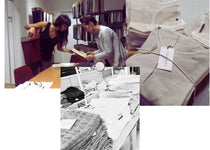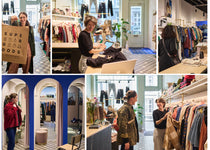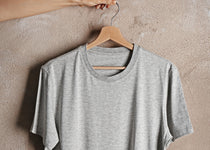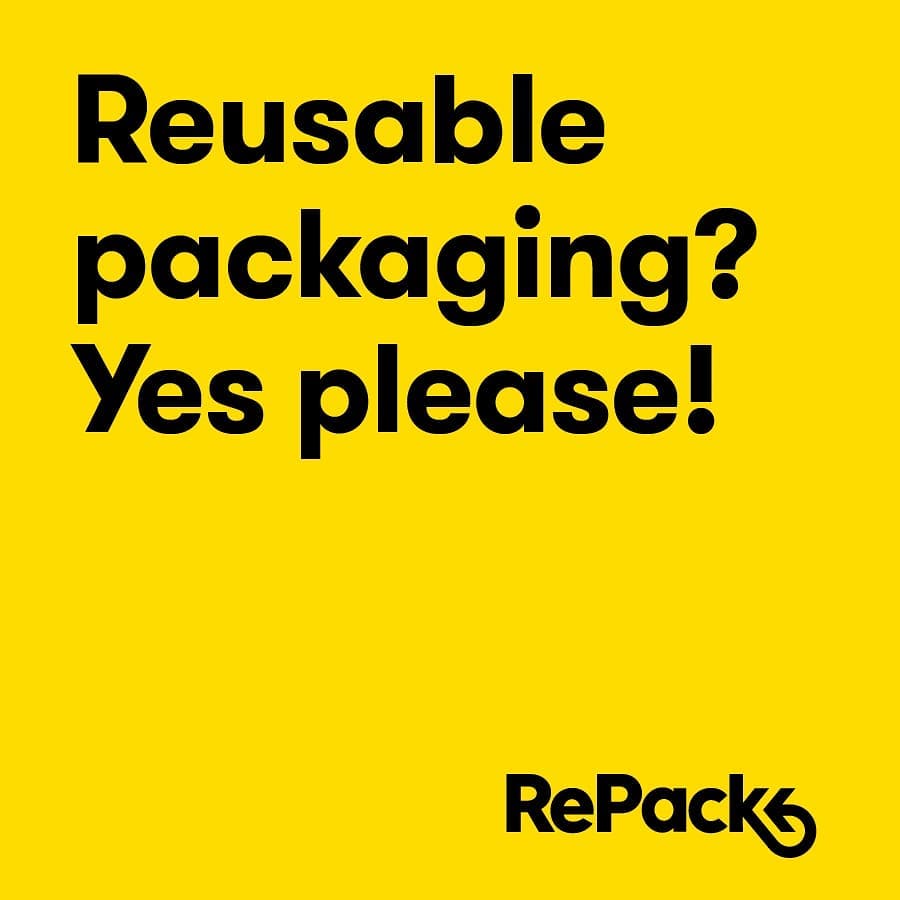
Fair fashion, what's the deal?

Healthy cotton farmers...
Fair fashion is about a lot more than just fair amounts of money or no child labor, and really starts with the healthy working conditions - take cotton farming for example: to grow 0,4 raw cotton for one T-shirt, an average of 0,165 kg of chemicals are used. Most of it serves to strip the cotton plants from their leaves to facilitate harvesting - which is a manual job. Cotton industry is the second most polluting industry in the world, the first being oil industry. And herbicides and pesticides are primarily very unhealthy for the cotton farmers and pickers themselves.3 out of 10 cotton farmers have serious health problems. The details are downright horrific. Statistically, every 8 hours a diseased cotton farmer commits suicide - he can not support his family anymore being very ill, and that is why.
Therefore, organic cotton is the right choice for those who want to work sustainably and fairly. And let's be honest: to add 6.25% organic cotton to plain cotton is pure greenwashing, and the result is certainly not eco fabric, right?

Other materials and upcycling
The durable fashion industry does plenty of experimenting with other materials. They are ranging from bamboo (fast growing and no chemicals needed) and silk (even eco silk, which is caterpillar friendly) to lyocell and tencel (which are environmentally friendly alternatives to of viscose which are cradle-to-cradle made of wood, and biodegradable, and antibacterial, and so on). Classics are also linen and hemp, of course. And happy sheep wool, etc.
Even more interesting is upcycling in fashion, where overstock fabrics are used, or literally clothes and fabrics that have been used already, for example in the army. This results in unique clothing, which sometimes still carry characteristics of a past in tiny details. Globe Hope is a good but certainly not the only example .
Obviously a fair price is to be paid for the materials. Organic cotton is one third more expensive than normal cotton. And other high-quality materials such as tencel justify their price - which is equally true for up cycled materials - nothing comes for free.

Colors
Cotton or other materials getting colored: this is where clothing often gets really toxic. Sustainable brands use certified colors, with no heavy metals, formaldehyde, chromium or other harmful materials. Besides, again, it's not just about your health: it is mainly the textile workers who may or may not have to deal with the toxins on a daily basis. Just so that you know. Fair is fair, right?
Fair production
The production of durable clothing is usually done in Turkey, Morocco, Tunisia, or Portugal, Latvia or other EU countries . The reason is simple. Those areas have a good or acceptable legislation on labor (including labor hours, child labor, safety, ...) with wages that meet acceptable minimum standards. In countries like Bangladesh and the likes, the problem is that the official minimum wage is much below even the targets of major confection chains. So the latter can not meet their targets and promises. Their subcontractors work according to the minimum wage of the country in question, being extremely low and not meeting sustainable standards. And we have not even mentioned other working conditions and rights of workers, who have no reliable legal framework in most Asian countries. So, mostly: no fair fashion.
Some clothing companies will on purpose work in Asian countries according to fair trade principles, to set an example. Komodo (production in India) and Studio JUX (production in Nepal and China among others) are good examples of this.
Certificates
There are many organizations and labels that certify certain aspects of sustainable fashion. Organic cotton can be GOTS, SOIL Association of Oekotex certified, companies can operate according to the principles of sustainability of Fair Wear Foundation or ISO140000 standards. And so on. Sometimes the clothing is not certified because the companies are in transition or have a coherent story otherwise. Certifications also have their price tag, you know. But that's food for an other blog, soon.
In any case, fair fashion is much more than just a financial issue, which is what people usually think and which is why fair fashion often carries the connotation of being more expensive. But first of all, fair fashion is not more expensive than branded clothing. Second of all, you are paying for a quality product, not throw-away fast fashion. And by buying directly from the cotton farmers and in other ways drastically shortening the chain from cotton field to shop, one can still get very close to prices from large clothing chains à la H&M. That will be proven by a fairly new clothing brand from Netherlands: Fair + Fair. Soon more.
Check out these fair fashion brands:

Gezonde katoenboeren...
Eerlijke mode is veel meer dan louter een financiële zaak of een zaak van geen kinderarbeid, en begint echt wel bij het materiaal - neem nu katoen: om 0,4 kg ruw katoen voor één t-shirt te telen, wordt gemiddeld 0,165 kg chemicaliën gebruikt. Een groot deel daarvan dient om de bladeren van te planten te laten vallen vlak voor het oogsten, zodat het oogsten, wat manueel werk is, makkelijker wordt. De katoenindustrie is na de olie-industrie de meest vervuilende ter wereld. Die herbiciden en pesticiden zijn in de eerste plaats erg ongezond voor de katoenboeren en -plukkers zelf.
3 op 8 katoenboeren heeft ernstige gezondheidsproblemen. De details hierrond zijn ronduit gruwelijk. Statistisch gezien pleegt er elke 8 uur een zieke katoenboer zelfmoord - hij kan zijn gezin niet meer onderhouden.
Daarom is biokatoen een logische keuze voor wie duurzaam of eerlijk wil werken. En laat ons eerlijk zijn: 6,25 % biokatoen toevoegen aan gewoon katoen is pure greenwashing, en het resultaat is geen ecotextiel.

Andere materialen en upcycling
In de duurzame kledingindustrie wordt volop geëxperimenteerd met andere materialen. Van bamboe (snelgroeiend en geen chemicaliën voor nodig) en zijde (zelfs eco-zijde, rupsvriendelijk) tot lyocell en tencel, milieuvriendelijke varianten van viscose die cradle-to-cradle worden gemaakt van houtafval en biologisch afbreekbaar zijn, en antibacterieel, enzovoorts. Klassiekers zijn ook linnen en hennep, natuurlijk. En schaapvriendelijke wol, enz.
Nog interessanter is de upcyclingkledingindustrie, die gebruikt maakt van restpartijen van stoffen, of letterlijk kledij en stoffen die bijvoorbeeld in het leger werden gebruikt, recycleert. Dat resulteert in unieke kledij die het karakter van een vorig leven vaak nog in de details met zich meedraagt. Globe Hope is hiervan een goed maar zeker niet het enige voorbeeld.
Uiteraard moet voor al de materialen een correcte prijs worden betaald. Biokatoen is 1/3e duurder dan normaal katoen. En andere hoogkwalitatieve materialen als tencel hebben hun prijs - wat trouwens evengoed geldt voor te upcyclen materialen - voor niets komt de zon op.

Kleuring
Het katoen of ander materiaal krijgt een kleurtje. Het is hier dat kledij vaak echt giftig wordt. Duurzame merken gebruiken gecertificeerde kleuren, zonder zware metalen, formaldehyde, chroom of andere schadelijke materialen in de stoffen. Trouwens, ook hier geldt: het zijn vooral de textielarbeiders die al dan niet te maken krijgen met de giftige stoffen, in mindere mate wij. Het is maar dat je het weet - eerlijk is eerlijk.
Eerlijke productie
De productie van duurzame kledij gebeurt meestal in Turkije, Marokko, Tunesië, of in Portugal of Letland of andere EU-landen. De reden is simpel. Daar is er een goede of acceptabele wetgeving rond arbeid (inclusief werkuren, kinderarbeid, veiligheid, ...) met lonen die voldoen aan specifieke minimumstandaarden. In Bangladesh en consoorten is het probleem dat de minimumlonen er een stuk onder de streefdoelen van grote ketens ligt. Zo kunnen ze hun streefdoelen en beloftes niet nakomen, omdat de ondercontractanten werken volgens de minimumlonen van het land in kwestie. Zo krijgen textielarbeiders bijzonder weinig betaald. En dan hebben we het nog niet over andere arbeidsomstandigheden en rechten van arbeiders, die geen sluitend wettelijk kader hebben in de meeste Aziatische landen. Geen eerlijke mode, dus.
Maar het is dat er in Oost-Azië geen goede voorbeelden te vinden zijn. Sommige kledingbedrijven gaan precies wél in Aziatische landen werken volgens fairtradeprincipes, om daar een voorbeeld te stellen. Komodo (productie in India) en Studio JUX (productie in Nepal en onder meer China) zijn hiervan goeie voorbeelden.
Certificaten
Er zijn heel wat organisaties en keurmerken die bepaalde aspecten van duurzame mode certificeren. Katoen kan GOTS, SOIL Association of Oekotex gecertifieerd zijn, bedrijven kunnen werken volgens de duurzaamheidsprincipes van Fair Wear Foundation of de ISO140000 standaard. Enzovoorts. Of net niet, omdat de bedrijven in omschakeling zijn of op een niet-gecertificeerde manier een sluitend verhaal hebben. Aan zo'n labels hangs namelijk ook een prijskaartje. Voer voor een volgende blog...
In elk geval is eerlijke mode veel meer dan louter een financiële kwestie, wat dan vaak de connotatie draagt van een soort 'duurheid'. Maar eerlijke mode is niet duurder dan merkkledij. En door rechtstreeks bij de katoenboeren te gaan inkopen en ook op andere manieren de keten van katoenveld tot winkel drastisch in te korten, komen we erg dicht bij prijzen die ook door grote confectieketens à la H&M komen. Dat bewijst een nieuw eerlijk kleding merk uit Nederland: Fair+Fair. Daarover binnenkort meer.





